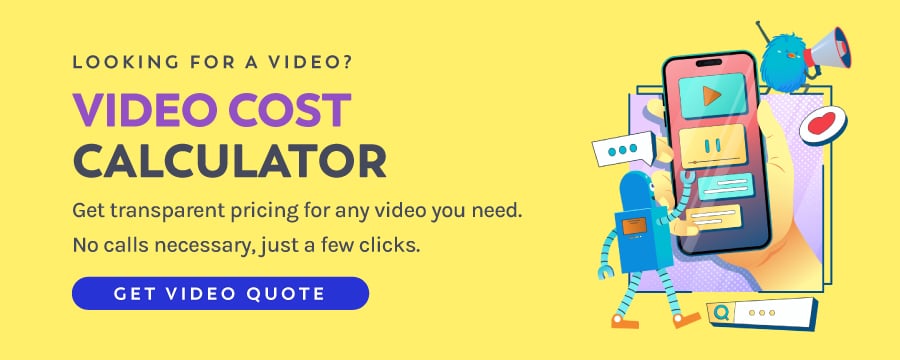I’ll be honest with you, boring videos are everywhere.
People scroll, tap, and skip like it’s second nature. So how do you fix it?
My best option is creating interactive videos.
Instead of just watching passively, your audience gets to click, choose, and actually be part of the story.
I’ve used this approach in projects, and I can tell you it changes the game.
Viewers don’t just watch longer, they engage deeper and are more likely to take action.
And if you’re not experimenting with interactive video yet… why not?
You’re probably leaving results on the table.
I’ll share with you interactive video essentials, applications, and some tips when creating one.
What is an Interactive Video?
An interactive video is a video that lets your audience take part in the experience.
Instead of just pressing play and watching passively, viewers can click buttons, answer questions, choose paths, or even shop directly inside the video.
That’s the big difference from a regular video. It’s not one-way communication.
Your audience gets to interact, and that interaction keeps them watching longer, makes the content more memorable, and encourages them to take action.
This highly engaging type of video drives more than a 47% increase in viewing times when compared to linear video ads.
There are some fun, exciting features that most interactive videos have, like swipe, scroll, click, and drag video content that effectively creates a unique video viewing experience.
With these features, interactive videos allow your audience to interact rather than just being passive viewers in front of the screen.
All the increased engagement you’ll get from interactive videos will lead to other advantages, including increased sales, additional brand awareness, and a boost in web traffic.
Types of Interactive Videos
So, how do you actually create an interactive video? The good news is, you don’t need to build everything from scratch.
There are plenty of tools out there designed to add clicks, quizzes, and branching paths without making your life complicated.
I’ve used interactive formats in projects ranging from marketing campaigns to training modules, and the key is always matching the type of video with what you want your audience to do.
Do you want them to learn something? Make a choice? Share feedback? Or simply be entertained?
Here are some of the most common types of interactive videos that work really well across industries:
1. Hotspots
Hotspots can automatically identify a specific shape and track any motion throughout your video.
It also provides clickable areas or buttons within a video that can direct audiences from one section of the video to another browser window, making it easier for you to encourage them to perform your desired actions.
Let’s say a person is walking down the street wearing a catchy shirt; you can put a noticeable link on that shirt. It creates a visual appeal to catch the audience’s attention and allows them to see the details and appearance of the product.
The well-executed interactive video above will gain you more insight into hotspots:
2. 360-degree Views
360-degree videos are now becoming the talk of the town.
In case the name doesn’t give anything away to you, this video captures every single angle on video, giving the audience a complete 360-degree view of a place or an event.
The audience can drag the screen to choose the direction they want to watch. With high-quality and real-time features, the 360-degree video gives them an immersive experience.
It helps them to place themselves in a particular place, just like in the video they watch.
This 360-degree view is a must-use interactive video, especially for the tourist and destination industries.
However, since this video needs more advanced technology to create, small businesses or startups with a shoestring budget have a bit of a tough time managing the production cost.
Using a 360-degree view for your interaction video not only allows you to immerse the audience to the next level but also shows them that your business is innovative and forward-facing.
Take a look at a stunning example of a 360-degree video from GoPro below:

3. Branching
With branching, you let your audience choose and create their adventure by providing them with interactive storytelling.
All you need to do is give them narrative-driven questions and let the audience decide the answer based on their interest by clicking one of the links that you put on the screen as options.
Next, they’ll be sent to another part of the video based on their reply.
This type of interactive video makes the audience spend more time on your video content.
Also, all the actions or choices are trackable, so you can understand your audience’s insights much better than before.
In the next campaign, you have a clear idea of how to personalize the video content for maximum results.
Look at this excellent example of branching from Philips below:
4. Live Streaming
I bet you’re already familiar with Instagram Live, Facebook Live, or YouTube Live- unless you’ve been living under a rock.
These live-streaming options are another example of an affordable way you can use interactive videos.
In fact, live-streaming videos recorded an audience reach of 91.4% among internet users worldwide
By running a live streaming video, you’d be able to establish a strong, more personal connection with your audiences.
It also makes it easier for them to ask some questions and get responses in real time from you.
Much of live streaming’s current popularity is around real-time chat, feedback, polls, live with a friend or an audience (at least Instagram has it), etc.
All those features make it easier for you to create and develop positive customer relationships and keep them coming back.
5. Quizzes
Another idea for your interactive video is to create quizzes. Gamification, like trivia, mini-quizzes, and more, can be easily integrated into your videos.
It’ll complement the video and make it more interactive.
The easiest way to place the quiz is by giving the audience a question (multiple choice questions, yes or no questions, open-ended questions, or even fill-in-the-blank questions) and also providing them with hints and the answer.
With mini-quizzes like that, you can effectively reinforce your brand’s message and improve knowledge retention of the audience.
Disney Channel is well-known for its interactive quiz videos on YouTube. Here’s one of them:
Applications Of Interactive Video
One of the best things about interactive video is how flexible it is.
You can use it to explain, teach, collect feedback, entertain, or even recruit new talent, and it works just as well across industries.
Because viewers aren’t just watching but actually taking part, interactive videos grab attention faster and keep people engaged longer.
That’s why you’ll see them everywhere, from marketing campaigns to training sessions.
Let’s break down a few video styles that work especially well with interactive features:
1. Explainer Videos
There is no more effective way of demonstrating how something works and is beneficial than with interactive explainer videos.
So it makes sense that explainer videos have been a popular type of video, especially in the marketing landscape.
This highly-performing video mostly uses endearing animated characters with a narrative-driven story as its core elements, which can help you create interactive visual video content.
Even with a simple interaction from the animated characters and a relatable story, an explainer video can transform how your audience experiences videos by making them more fun, captivating, engaging, and, most importantly, memorable.
Read More: The Definitive Guide to Explainer Videos
2. Educational Videos
Interactive video is such a vital tool in online education as it offers an effective way to improve engagement and retention.
It was born out of the pursuit to make online learning more fun and enjoyable.
The interactive features, such as branching scenarios, hotspots, and quizzes, allow the learner to interact through their learning journey.
That’s why they’ll be convinced to spend more meaningful time in the learning process.
That’s not all.
Using interactive videos for online learning also develops the learner’s problem-solving skills and sparks their creativity since they’re not a passive learner who just watches and sits.
3. Customer Feedback
Now that your audiences seem engaged with your interactive videos, it’s a perfect time to get their feedback on your video.
Adding interactivity to your videos makes it easier for you to get their input and opinions beforehand.
In this matter, you can create a poll or a short question that gauges the audience’s interest and get their opinion about your video, your brand, your service, or just your marketing campaigns in general.
Make sure you ask them a simple, straightforward question to get feedback.
Don’t forget to also make it as enjoyable as possible.
Let your busy audiences answer and return immediately to their business.
The data from the feedback can help you shape a better strategy for your next video campaigns.
4. Entertainment
Since interactive videos allow the audience to take control and customize the content, it’s an ideal medium for entertainment.
Interactive videos are pretty much giving the audience a game-based viewing experience, providing them with a slice of entertainment.
With interactive videos, giving your audience both information about your brand and bits of entertainment at the same time becomes much easier than ever.
You can rely heavily on compelling storytelling, so the audience is much more likely to feel engaged and entertained by the content.
5. Recruitment Videos
When it comes to the next-gen recruiting process, interactive videos may be the best in class.
Integrating a bit of interactivity in recruitment videos can effectively gain the candidate’s attention and generate excitement.
By giving candidates optional interactive features, they can choose the specific aspects of the role that they’re interested in without having to read all of the information, which can confuse and overwhelm the applicants.
For recruiters, interactive recruitment videos are handy tools to reach savvy, top talent that can get the company off the ground.
For some candidates, it might be the appealing medium offered by a company that is most engaging and inviting.

Reasons To Create an Interactive Video
More and more brands are now tapping into new ways of engaging more audiences through interactive videos.
It’s crucial to actually understand and see what all the fuss is about.
And just in case all the right points about interactive videos above aren’t strong enough to convince you, I’m going to break down the reasons to create an interactive video:
1. Well-Liked By Viewers
Who doesn’t like being informed and entertained at the same time? That is what makes interactive videos well-liked by audiences.
Since interactive videos let the audience lean forward and take part, it’s easy to fall in love with these highly engaging videos.
So, it shouldn’t come as a surprise that now interactive video is rapidly becoming the new standard.
Interactive video is an umbrella under which unique, innovative viewing experiences give the audience a reason to keep coming back for more.
2. Easy to Track
What if you could discover what precisely every potential customer is looking for, present the perfect sales pitch, and even better, get more conversions?
Ecstatic, isn’t it?
Another reason that makes interactive videos too powerful to ignore is the accessibility to track.
With every click of a button, you gain useful insights into your audience’s behavior and preferences.
It means that integrating interactive videos into your video campaigns creates the opportunity for you to continuously keep an eye on and follow up with specific audiences, as well as capture value from your target customers’ insights and data.
For marketing purposes, that data is instrumental in gaining competitive intelligence on future market conditions.
Meanwhile, for educational uses, the data can help you to get a solid grasp on how every single learner consumes or digests information, so you’ll understand what type of content they like the most and least.
3. Engages Your Audience
The purpose of an interactive video boils down to one thing: driving better engagement.
Your audiences are fickle. They are only a few clicks away before they move to other things.
That’s mostly because of the popularity of shorter media forms that enable their dwindling online attention spans.
That’s why catching their attention and holding it are such a necessity.
Thankfully, interactive videos are purposely designed to grab their attention and convince them to spend more time on the video.
When an audience is interacting with a video, their attention stays on the content. It is not only effective to make them stay but also to stick around.
4. Converts Better
Do you know what happens after you successfully engage your audience? More conversions!
Linear videos are great, and all for boosting conversion, but interactive videos can do it better.
An interactive video turns viewers into customers as you can seamlessly add calls-to-action, such as shiny buttons and links to it.
Other fun interactive features, like quizzes or branching, can also provide your audience with a sense of satisfaction to incentivize conversion.
It can also be used on a special occasion like Black Friday or a Holiday limited discount online event.
With more viewers turned into customers, you’ll also get more generated leads, newsletter subscribers, and boosted sales, which is a crucial KPI for most marketing initiatives.
5. Easier to Remember
One of the critical objectives of interactive video is ensuring the audience is in control, which results in more meaningful and impactful video content.
And it also makes the whole video experience more exciting.
With such a positive viewing experience, the audience is more likely to remember the video and your brand, even if they don’t make a purchase.
According to statistics, interactive videos are 32% more memorable than non-interactive ones.
Now that you and your competitors have to compete for attention in a crowded digital marketplace, interactive video can be a solution for getting a competitive edge to earn more audience attention.
Best Practices for Your Interactive Videos
Interactive videos can be much more than linear videos, as they are a platform where the audience can directly do more with the content than passively watch it.
At this point, it’s safe to say that interactive videos seem to have a lot to offer compared to other types of videos.
Now the question is: how to create one that actually works?
1. Use Interaction Considerately
We get it. Interactive videos are not only exciting for the audience to watch, but also it’s fun to create.
You might be thinking, “More interaction, more engagement.”
So, you put links here, branches there, and some quizzes in the middle, or maybe put all the buttons you could ever think of, so the audience doesn’t miss a thing from your brand.
Sadly, it’s not the way it works.
You need to use interaction wisely and considerately. Or else, it’ll turn out to be an epic fail.
Too many interactions make your audience confused. They may even think that your video is way too intrusive and annoying as they’re being bombarded with all the buttons and links.
By all means, you need to focus on your goal of creating an interactive video. Next, use the relevant interaction as efficiently as possible.
2. Gamify the Experience
Interactive video makes purchasing journeys and online learning much more fun through the concept of games.
In marketing, compelling video marketing isn’t only involved with product features and benefits, but also a pleasant audience feeling. And riveting storytelling isn’t enough.
You can add game elements to instructional design and use reward systems for more audience engagement.
Include typical aspects of gameplay, like scoring, competition, or solution, so that the audience can get a more positive sense of participation.
3. Create a Fun Experience
Your audience will come back if they enjoy your content since they want more of it.
In this case, creating a fun experience in your interactive video is vital.
It can help you catch the audience’s attention in ways that linear videos don’t always succeed in doing.
And you need to make sure that all the interactive features you put on the video are both fun and enjoyable.
The fun experience is one of the reasons they stick around your video content.
4. Let the Viewer Play a Part
With the endless amount of information available today, your audience is struggling to consume traditional content where they have to become a passive audience.
They want to take part in the content and get immersed in it.
In interactive videos, audience participation is a must- after all, that is what makes interactive videos different from usual traditional or linear videos.
Create an interactive environment that prompts a response from the audience.
Try to include the current situation or the newest trends so you can convince the audience to participate.
Interactivity Is The New Norm
After years of being dubbed as an emerging tactic in video marketing campaigns, interactive videos are now finally being made mainstream.
Unlike traditional videos, interactivity puts your audience in the driver’s seat.
They click, choose, explore, and actually shape how they consume your content.
That level of engagement keeps attention longer and drives stronger actions, whether it’s learning, buying, or sharing.
While attention spans keep shrinking, interactive video gives you an edge.
It turns passive viewers into active participants
FAQs on Interactive Videos
1. Why should I use interactive videos in my marketing?
Because attention spans are short, and too much noise in regular videos. Interactive videos make your brand stand out and keep people engaged longer. More importantly, they naturally guide viewers toward actions like signing up, buying, or sharing.
2. Are interactive videos expensive to create?
Not necessarily. There are plenty of tools that make it easier and more affordable than you might think. I’ve worked with both simple, low-cost solutions and more advanced custom builds. It really depends on your goals and budget.
3. What industries benefit the most from interactive videos?
Almost all of them. I’ve seen interactive videos work well for education, recruitment, entertainment, internal training, and of course, marketing. If your audience needs to learn, engage, or decide, interactive video can help.
4. How do I measure success with interactive videos?
Unlike regular videos, you’re not just looking at views. With interactive video, you can track clicks, choices made, time spent, and even conversions. This gives you way more insight into how people actually engage with your content.
5. Can I use interactive video on social media?
Some platforms (like YouTube) allow basic interactivity, but most social media platforms have limits. That’s why a lot of brands host interactive videos on their website or use dedicated platforms, then promote them through social channels.
Start capturing the attention of your audience with interactive videos.
Breadnbeyond is ready to take your upcoming campaign to the next level. Check out our packages and claim your FREE consultation!
Or try our video cost calculator below to get an instant estimation of your project!






